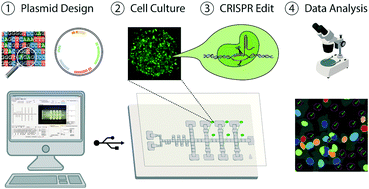Our official English website, www.x-mol.net, welcomes your
feedback! (Note: you will need to create a separate account there.)
An automated microfluidic gene-editing platform for deciphering cancer genes†
Lab on a Chip ( IF 6.1 ) Pub Date : 2018-07-10 00:00:00 , DOI: 10.1039/c8lc00470f Hugo Sinha 1, 2, 3, 4, 5 , Angela B. V. Quach 2, 3, 4, 5, 6 , Philippe Q. N. Vo 1, 2, 3, 4, 5 , Steve C. C. Shih 1, 2, 3, 4, 5
Lab on a Chip ( IF 6.1 ) Pub Date : 2018-07-10 00:00:00 , DOI: 10.1039/c8lc00470f Hugo Sinha 1, 2, 3, 4, 5 , Angela B. V. Quach 2, 3, 4, 5, 6 , Philippe Q. N. Vo 1, 2, 3, 4, 5 , Steve C. C. Shih 1, 2, 3, 4, 5
Affiliation

|
Gene-editing techniques such as RNA-guided endonuclease systems are becoming increasingly popular for phenotypic screening. Such screens are normally conducted in arrayed or pooled formats. There has been considerable interest in recent years to find new technological methods for conducting these gene-editing assays. We report here the first digital microfluidic method that can automate arrayed gene-editing in mammalian cells. Specifically, this method was useful in culturing lung cancer cells for up to six days, as well as implementing automated gene transfection and knockout procedures. In addition, a standardized imaging pipeline to analyse fluorescently labelled cells was also designed and implemented during these procedures. A gene editing assay for interrogating the MAPK/ERK pathway was performed to show the utility of our platform and to determine the effects of knocking out the RAF1 gene in lung cancer cells. In addition to gene knockout, we also treated the cells with an inhibitor, Sorafenib Tosylate, to determine the effects of enzymatic inhibition. The combination of enzymatic inhibition and guide targeting on device resulted in lower drug concentrations for achieving half-inhibitory effects (IC50) compared to cells treated only with the inhibitor, confirming that lung cancer cells are being successfully edited on the device. We propose that this system will be useful for other types of gene-editing assays and applications related to personalized medicine.
中文翻译:

自动化的微流控基因编辑平台,用于破译癌症基因†
基因编辑技术(例如RNA引导的核酸内切酶系统)在表型筛选中正变得越来越流行。此类筛选通常以阵列或合并格式进行。近年来,人们非常感兴趣地寻找进行这些基因编辑测定的新技术方法。我们在这里报告的第一个数字微流控方法,可以自动在哺乳动物细胞中进行阵列的基因编辑。具体而言,该方法可用于最多培养六天的肺癌细胞,以及实施自动基因转染和敲除程序。此外,在这些程序中还设计并实施了用于分析荧光标记细胞的标准化成像管线。肺癌细胞中的RAF1基因。除基因敲除外,我们还用抑制剂索拉非尼甲苯磺酸盐处理细胞,以确定酶促抑制作用。与仅用抑制剂处理的细胞相比,酶促抑制和靶向设备的导向相结合导致更低的药物浓度,以实现半抑制作用(IC 50),从而证实了肺癌细胞已在设备上成功编辑。我们建议该系统将用于其他类型的基因编辑分析以及与个性化医学相关的应用。
更新日期:2018-07-10
中文翻译:

自动化的微流控基因编辑平台,用于破译癌症基因†
基因编辑技术(例如RNA引导的核酸内切酶系统)在表型筛选中正变得越来越流行。此类筛选通常以阵列或合并格式进行。近年来,人们非常感兴趣地寻找进行这些基因编辑测定的新技术方法。我们在这里报告的第一个数字微流控方法,可以自动在哺乳动物细胞中进行阵列的基因编辑。具体而言,该方法可用于最多培养六天的肺癌细胞,以及实施自动基因转染和敲除程序。此外,在这些程序中还设计并实施了用于分析荧光标记细胞的标准化成像管线。肺癌细胞中的RAF1基因。除基因敲除外,我们还用抑制剂索拉非尼甲苯磺酸盐处理细胞,以确定酶促抑制作用。与仅用抑制剂处理的细胞相比,酶促抑制和靶向设备的导向相结合导致更低的药物浓度,以实现半抑制作用(IC 50),从而证实了肺癌细胞已在设备上成功编辑。我们建议该系统将用于其他类型的基因编辑分析以及与个性化医学相关的应用。











































 京公网安备 11010802027423号
京公网安备 11010802027423号